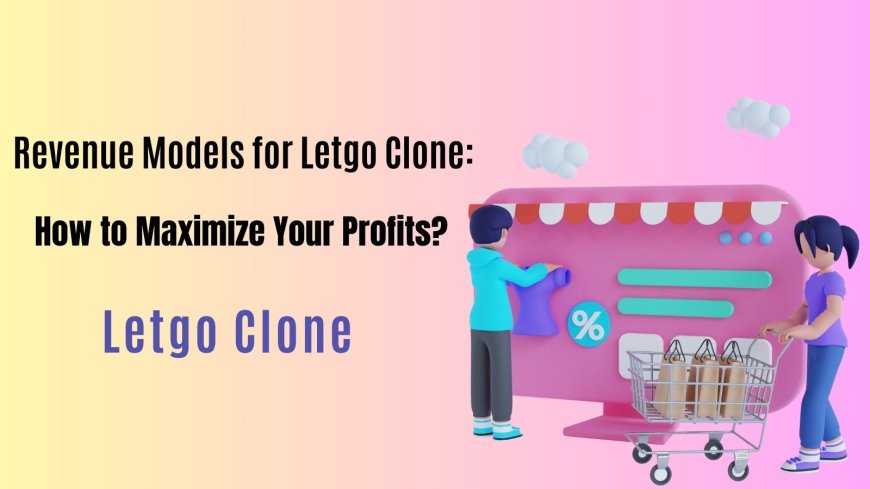Revenue Models for Letgo Clone: How to Maximize Your Profits?

Thinking of launching a Letgo clone?
Great choice!
With more people buying and selling online, this is a growing market.
But how do you earn money with your marketplace application?
In this blog, I will list the top revenue models that help you turn your Letgo clone script into a money-making machine.
So, without delay, let’s dive in…
Top Monetization Models for Your Letgo Clone
1. Listing Fees: Charge for Visibility
One of the simplest ways to generate revenue is by charging users to list their products. When sellers pay to list their items, they get more engagements for their listings and reach more buyers. It’s a win-win.
To make this work:
-
Offer tiered pricing. For instance, basic listings are free while having a nominal charge for premium listings.
-
Provide incentives, such as paid listings will appear on the first page of search results or be featured at the top of home page.
Why It Works: There are tons of sellers who will pay for increased exposure - especially within a competitive market.
2. Transaction Fees: Take a Commission out of Each Sale
Another hit revenue model in the play is the transaction fee.
That is, a small cut taken from each of the sales made through your app.
In this model, your revenue will directly coincide with the success of your users: the more they sell, the more you get.
To accomplish this:
-
Determine an appropriate percentage. Most transaction fees run between 2% to 10% percent.
-
Provide secure payment processing in your Best Letgo clone script so as to build trust in the users.
Why it works: This will motivate users to continue using your platform since they will only be paying for the sales generated.
3. Premium Memberships: Special Benefits Users Get
Provide a subscription plan whereby extra features and tools are made available to the seller to augment their sales.
Other possible privileges for premium members:
-
Unlimited product listing.
-
Priority customer support.
-
Advanced analytics on their sales.
-
Exclusive access to new features.
Why it Works: Serious sellers looking to do business will pay for special subscription benefits that give them an edge.
4. In-App Advertising: Sell Advertising Space
Selling ad spaces is another brilliant way of monetizing your Letgo script.
Let other relevant third-party businesses advertise their products on your app.
For example, they might want to pay to feature their products/services on the homepage, category listing, and search results.
Here's how to get started:
-
Diversify your advertising offers, including sponsored listings, banner ads, and push notifications.
-
Set a pricing structure based on visibility and reach.
Why it works: More often, businesses are willing to improve their products’ reach. They may consider advertising in your platform-especially if your application enjoys millions of users.
5. Commission-based Model: Earn as They Sell
Commission-based models are similar to transaction fees but with added flexibility. Instead of having just a flat percentage, you could establish commission rates based on product categories or sales volume.
Here's how:
-
Set low commissions for big-ticket items while setting high commissions for smaller ones.
-
Offer acceptable commission rates to drive more activity on your platform.
Why it Works: Sellers will appreciate this model since it is a reward for high-volume sales and encourages them to sell more.
6. Paid App Downloads: Charge a Fee to Download
This paid download model is less common for marketplaces but still works. Charge your users a one-time fee to download the app. This will perfectly work if your app offers anything special that the free version doesn't have.
How to leverage this model:
-
Offer free trials or demos of your platform for acquiring initial users.
-
Emphasize in your marketing those features and benefits that are unique.
Why it Works: The upfront charging for the app may bring instant revenues, though at the cost of a limited starting user base.
7. Monetization of Data: Monetize User Data
The value of users' data can be commercialized: by analyzing user behavior, preferences, and trends to provide target advertisements or personalized services ethically.
To get started:
-
Collect anonymized data to maintain privacy.
-
Partner with brands or businesses whose core can be influenced by the insight into user behavior.
Why it works: Businesses will pay for data insights to better reach the right audience.
8. Branded/Sponsored Content: Brand Partnerships
Another stream of revenue could be sponsored content. Partnerships with brands could lead to the creation of content that resonates with an audience, be it product reviews, tutorials, or sponsored listings.
How to implement:
-
Approach brands that align with your user base.
-
Offer various types of sponsorship packages, such as front-page or via email promotions.
Why it Works: Brands will forever be looking for new ways to get in touch with prospective customers. Your platform can be an amazing medium for them.
9. Virtual Currency: In-app Currency Creation
Virtual currencies or credits can also be an innovative way of monetizing. Let the users purchase virtual coins or tokens that they can use within the app for listing products, promoting items, or using some sort of premium features.
How to implement:
-
The conversion rate of real money to virtual money should be clearly defined.
-
Offer discounts to the users in order for them to buy more virtual coins.
Why it works: Virtual currency keeps transactions in your app, boosting user engagement and spending.
10. In-app Purchases: Sell Additional Features
Offer more additional personal in-app purchases beyond the premium memberships. Everything from more storage space to enhanced filters or advanced search can be included.
How to make it work:
-
Identify the features users are willing to pay for.
-
Keep prices reasonable to encourage frequent purchases.
Why it works: In-app purchases can seem like small micro-transactions. But it add up over time and creates a consistent revenue stream.
11. Crowdfunding and Donations
Leveraging community support and crowdfunding is not a traditional revenue model, but it definitely works. Once your application solves some specific problem, or you have a great community around it-just ask for donations or crowdfund to innovate new features.
To do so:
-
Create a crowdfunding campaign to explain what the funds are needed for.
-
Reward donors with gifts or acknowledgments.
Why it works: Those who believe in your mission will financially support it.
Conclusion
Letgo clone script presents enumerable opportunities for revenue generation.
What is important is to choose models that best suit your business objectives and users' needs. Progress with a few, analyze the results, and adjust as needed.
Let me repeat: The best Letgo clone is one that serves your users well, which in turn will bring in the revenues consistently.
Now, take the plunge, implement these models, and watch your app thrive!
What's Your Reaction?


























